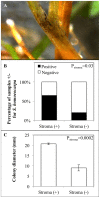Sclerotinia homoeocarpa overwinters in turfgrass and is present in commercial seed
- PMID: 25333928
- PMCID: PMC4204931
- DOI: 10.1371/journal.pone.0110897
Sclerotinia homoeocarpa overwinters in turfgrass and is present in commercial seed
Abstract
Dollar spot is the most economically important disease of amenity turfgrasses in the United States, yet little is known about the source of primary inoculum for this disease. With the exception of a few isolates from the United Kingdom, Sclerotinia homoeocarpa, the causal agent of dollar spot, does not produce spores. Consequently, it was assumed that overwintering of this organism in soil, thatch, and plant debris provides primary inoculum for dollar spot epidemics. Overwintering of S. homoeocarpa in roots and shoots of symptomatic and asymptomatic creeping bentgrass turfgrass was quantified over the course of a three-year field experiment. Roots did not consistently harbor S. homoeocarpa, whereas S. homoeocarpa was isolated from 30% of symptomatic shoots and 10% of asymptomatic shoots in the spring of two out of three years. The presence of stroma-like pathogen material on leaf blades was associated with an increase in S. homoeocarpa isolation and colony diameter at 48 hpi. Commercial seed has also been hypothesized to be a potential source of initial inoculum for S. homoeocarpa. Two or more commercial seed lots of six creeping bentgrass cultivars were tested for contamination with S. homoeocarpa using culture-based and molecular detection methods. A viable, pathogenic isolate of S. homoeocarpa was isolated from one commercial seed lot and contamination of this lot was confirmed with nested PCR using S. homoeocarpa specific primers. A sensitive nested PCR assay detected S. homoeocarpa contamination in eight of twelve (75%) commercial seed lots. Seed source, but not cultivar or resistance to dollar spot, influenced contamination by S. homoeocarpa. Overall, this research suggests that seeds are a potential source of initial inoculum for dollar spot epidemics and presents the need for further research in this area.
Conflict of interest statement
Figures



References
-
- Allen TW, Martinez A, Burpee LL (2005) Dollar spot of turfgrass. Plant Health Instr doi:101094/PHI-I-2005-0217-02
-
- Vargas JMJ (1994) Management of turfgrass diseases. 2nd edition. Lewis Publishing.
-
- Walsh B, Ikeda SS, Boland GJ (1999) Biology and management of dollar spot (Sclerotinia homoeocarpa); an important disease of turfgrass. HortScience 34: 13–21.
-
- Goodman DM, Burpee LL (1991) Biological control of dollar spot. Phytopathology 81: 1438–1446.
-
- Watkins JE, Shearman RC, Gaussoin RE, Cecil WK, Vaitkus M, et al. (2001) An integrated approach to dollar spot management on a bentgrass fairway. Int Turfgrass Soc Res J 9: 729–735.
MeSH terms
LinkOut - more resources
Full Text Sources
Other Literature Sources

